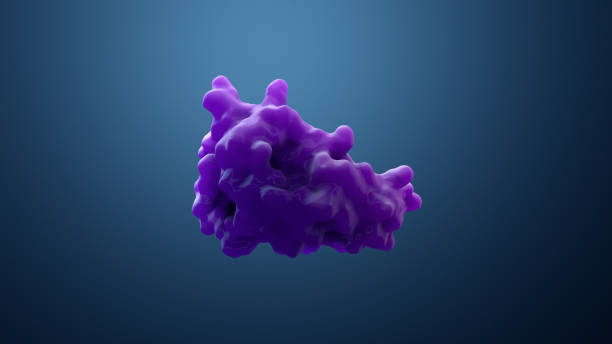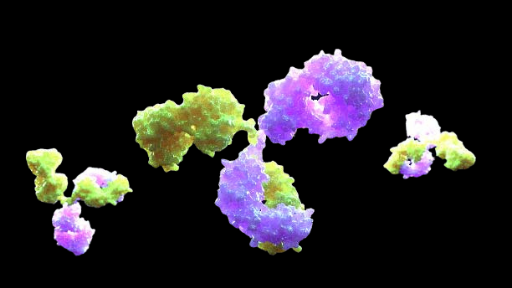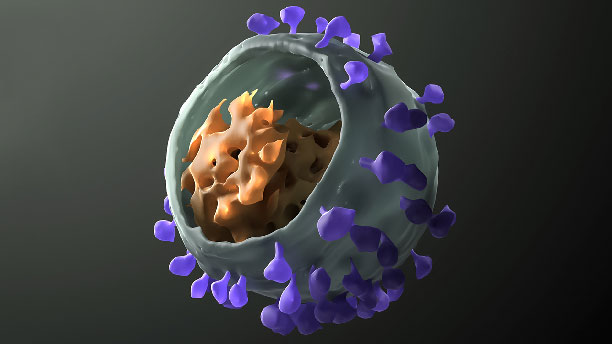Notch signalling regulates a diverse array of cell fate decisions in multiple tissues during both development and homeostasis, including lineage commitment, differentiation, cell cycle progression, and maintenance and self-renewal of stem cells. The canonical Notch cascade operates in a cell–cell contact-dependent manner, and is initiated when ligands expressed by a signal-sending cell ligate receptors expressed on a signal-receiving cell. In mammals, there are four Notch receptors (NOTCH1, NOTCH2, NOTCH3 and NOTCH4 (NOTCH1–4)) and five ligands of the Delta–Serrate–Lag (DSL) family (jagged 1 (JAG1), JAG2, delta-like 1 (DLL1), DLL3 and DLL4). Structurally, the Notch receptors are single-pass transmembrane heterodimers consisting of an extracellular ligand-binding domain and an intracellular domain comprising a transmembrane region and an intracellular portion that mediates signalling upon receptor ligation. Notch receptors contains multiple epidermal growth factor (EGF)-like repeats, which are important for ligand binding, as well as a negative regulatory region (NRR) that contains a smaller number of LIN12-NOTCH repeats and the heterodimerization domain.
The NRR ensures that Notch signalling is inactive in the absence of interactions with DSL ligands1. The NRR prevents ligand-independent Notch activity. Before transport to the cell surface an S1 cleavage mediated by furin-like convertase occurs in the Golgi within the HDD, which is thought to be important for the generation of the mature receptor, although the precise function is unclear. The intracellular domain contains the recombining binding protein suppressor of hairless (RBPJ) association molecule (RAM), ankyrin repeats (ANK) that contain nuclear localization signals (NLSs) in NOTCH1–3 (the NLS domain in NOTCH4 is not well defined), a transactivation domain (TAD) and a polypeptide enriched in proline, glutamate, serine and threonine (PEST) sequence important for degradation of the receptor. Interaction between NOTCH1–4 and ligand jagged1 (JAG1), JAG2 or delta-like 1 (DLL1), DLL3 or DLL4 results in an S2 cleavage in the extracellular portion close to the transmembrane domain mediated by disintegrin and metalloproteinase domain-containing protein (ADAM) metalloproteinases. This removes the ligand binding domain, leaving the intracellular portion anchored to the plasma membrane. Subsequently, an S3 cleavage in the transmembrane domain mediated by the γ?secretase complex liberates the intracellular.
References
1.Nowell CS, Radtke F. Nat Rev Cancer. 2017;17(3):145–159.
Porcupine (Porcn), a member of the membrane bound O-acyltransferase (MBOAT) family, and is required for Wnt secretion and signaling. MBOATs are further categorized into three subgroups based on their biochemical reactions: lipid biosynthesis, sterol acylation and acylation of secreted proteins/peptides, including the appetite stimulating peptide hormone ghrelin and the hedgehog (Hh) and Wnt morphogen families.MBOATs are predicted to have 8–12 transmembrane domains (TMDs) and localize in the protein secretory pathway. The endoplasmic recticulum resident enzyme, porcupine (PORCN) is essential for the palmitoleation of the Wnt ligands at the highly conserved serine residue 209 before their secretion. Secreted Wnt proteins play key roles in embryonic development, tissue homoeostasis and stem cell self-renewal; among the 19 Wnt proteins encoded in humans, Wnt3a is the most extensively studied isoform. An early report that PORCN palmitoylated Wnts at a cysteine residue in the N-terminal region (Cys77 in Wnt3a) has been shown to be erroneous. The membrane bound O-acyl transferase (MBOAT) PORCN has emerged as a molecular target of interest in the search for more clinical options to treat Wnt-driven cancers.
References
1.Ho SY,et al. Bioorg Med Chem Lett. 2015;25(23):5472–5476.
2.Masumoto N, et al. Biochem Soc Trans. 2015;43(2):246–252.
The Hh pathway is controlled by two membrane proteins, Patched (Ptch), the Hh receptor, and Smoothened (Smo), a Class F G protein-coupled receptor (GPCR) which transduces the activation signal to downstream pathway components. In the absence of Hh ligand, Ptch inhibits signaling by Smo. Binding of Hh to Ptch triggers its internalization and degradation, thereby allowing Smo to accumulate and signal to intracellular effectors. Drosophila Smo appears to govern a sole canonical signal that culminates in activation of a Gli transcription factor, vertebrate Smo can activate two independent signaling arms. The canonical signal is dedicated to regulation of Hh target gene activation through Gli transcriptional effectors, and is thought to occur in a G protein-independent manner. Regulation of Gli phosphorylation by cyclic AMP (cAMP)-dependent protein kinase (PKA) is paramount to controlling transcriptional repressor and activator formation. Signaling from Smo to PKA and Sufu, a negative regulator of Gli activity, occurs in the PC and is dependent upon Smo interaction with the Ellis van Creveld Syndrome (Evc2) ciliary complex. Conversely, the noncanonical route utilizes Gαi to regulate cellular processes including metabolism, proliferation, Ca2+ flux and migration.
References
1.Arensdorf AM,et al. Trends Pharmacol Sci. 2016;37(1):62–72.
TNIK was originally identified as a new member of the Germinal Center Kinase (GCK) family. It is known that TNIK regulates the c‐Jun N‐terminal kinase (JNK) pathway through its C‐terminus and the nuclear factor‐κB (NF‐κB) signaling pathways through its N‐terminal kinase domain. In addition, TNIK has been shown to regulate the filamentous‐actin (F‐actin) cytoskeleton. TCF‐4, β‐catenin and TNIK proteins form a complex in colorectal cancer cells. TNIK phosphorylates the TCF‐4 protein at the conserved serine. This phosphorylation is essential for full activation of Wnt signaling. Knockdown of TNIK decreased the transcriptional activity of the TCF‐4 and β‐catenin complex and inhibited the growth of colorectal cancer cells and xenografts. This growth inhibition was abrogated by expression of the catalytic domain of TNIK.
The regulation of Wnt signaling by TNIK is conserved across species. Xenopus TNIK lacks the C‐terminal regulatory portion that is present in human TNIK, but the kinase domain is conserved. Xenopus TNIK is also essential for β‐catenin‐mediated determination of the dorsal axis. TNIK is an essential regulatory component of Wnt signaling, and colorectal cancer cells are highly dependent upon the expression and catalytic activity of TNIK for proliferation. Targeting of TNIK for pharmacological intervention was, thus, anticipated to inhibit Wnt signaling and suppress the growth of colorectal cancer cells.
References
1.Yamada T,et al. Cancer Sci. 2017;108(5):818–823.
The Wnt/β-catenin pathway is activated when a Wnt ligand binds to a seven-pass transmembrane Frizzled (Fz) receptor and its co-receptor, low-density lipoprotein receptor related protein 6 (LRP6) or its close relative LRP5. The formation of a likely Wnt-Fz-LRP6 complex together with the recruitment of the scaffolding protein Dishevelled (Dvl) results in LRP6 phosphorylation and activation and the recruitment of the Axin complex to the receptors. These events lead to inhibition of Axin-mediated β-catenin phosphorylation and thereby to the stabilization of β-catenin, which accumulates and travels to the nucleus to form complexes with TCF/LEF and activates Wnt target gene expression.Two distinct classes of Wnt inhibitors are the Dickkopf (Dkk) family and the Wise/SOST family. Dkk proteins, exemplified by Dkk1, are LRP5/6 ligands/antagonists and are considered specific inhibitors for Wnt/β-catenin signaling.
References
Bryan T. MacDonald et al.Dev Cell. 2009 Jul; 17(1): 9–26.

新靶点

新产品

天然产物

定制产品
一种黄酮类化合物,可以从柘木的根皮中分离得到
源于 Glycyrrhiza uralensis Fisch.,是一种 β 分泌脢 1 (BACE-1) 抑制剂。
从 Boenninghausenia japonica 中分离得到,具有抗细胞增殖活性,可用于癌症研究。
Lansiumamide B is a useful organic compound for research related to life sciences.
The herbs of Spiraea hypericifolia L.
Wampetin is a useful organic compound for research related to life sciences.
The herbs of Cistanche tubulosa.
The herbs of Sinopodophyllum hexandrum.
The herbs of Phyllanthus piscatorum.



